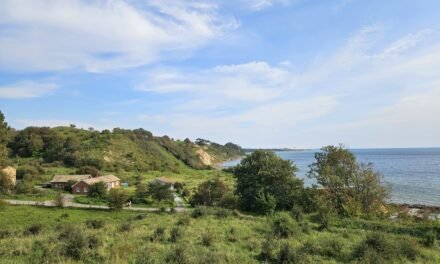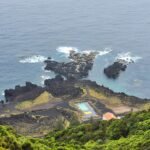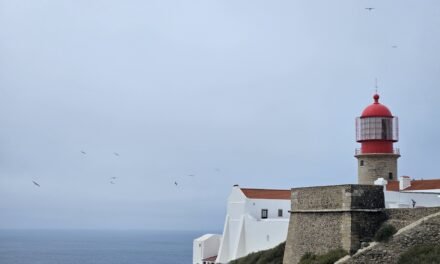
Journey to Jægerspris: In the Footsteps of Giants and Kings

Every trail tells a story, but few paths weave a narrative as rich and as ancient as the one leading to Jægerspris. Nestled on the edge of Roskilde Fjord, our hike to this storied place was more than a simple foray into the wilderness; it was a walk through history, flanked by the silent witnesses of the past: the oldest trees of Northern Europe.

A field of wheet and the fjord beyond
Jægerspris and Its Castle Keep
Our adventure started at the Jægerspris Castle, reached by a quaint bus ride from the harborside town of Frederikssund, itself a mere S-train ride from Copenhagen. En route, the Roskilde Fjord stretched out beside us, reminding us of the Vikings who once sailed these waters on their epic journeys.
Jægerspris itself is a little gem of a town. It’s got this cozy and laid-back vibe, reminding of a simpler Danish lifestyle, creadled by the fjord’s tranquility. When we got to the castle in Jægerspris, you could almost hear the walls telling stories of old romances and legends. It was here in the 1830s that Louise Rasmussen, a figure of grace and determination, caught the eye of Crown Prince Frederik, binding their fates in a controversial romance that echoed through the Danish monarchy.

A Royal Romance
Louise Rasmussen, later known as Countess Danner, was a woman whose life was as intriguing as it was controversial. Born in 1815 to humble origins, Louise’s journey from an illegitimate child of a maiden and nobelman to a renowned dancer and actress set the stage for a royal romance that would defy the norms of 19th-century Danish society. Namely her pursue for a career in ballet and as an actress led to meeting Prince Frederik. Their connection sparked in a realm where social hierarchies were stricktly enforced, making their relationship as a royal descent and a commoner scandalous. Frederik, known for his liberal views, was already in an unhappy marriage with Princess Vilhelmine, which eventually ended in divorce.
After Frederik ascended to the throne in 1848 as King Frederik VII, and following his divorce, he and Louise Rasmussen married in 1850. The marriage was groundbreaking and defying social norms. She was only granted the title of Countess Danner, so she never ascended to queenhood due to the strict hieararchy. Louise’s new role as Countess drew mixed reactions. While some admired her intelligence and charisma, others could not look past her origins and background. Despite the controversies, their marriage was said to be a happy one.
Following King Frederik VII’s death in 1863, Louise’s legacy continued through her charitable endeavors. She transformed Jægerspris Castle, a gift from Frederik, into an orphanage, leaving behind a legacy of compassion and change. And what is left from this royal romance was the Danneregen, an oak sapling from the mighty ‘Kongeegen”, where we were headed towards. The oak sapling was planted with royal hands in 1986.

The stretches of Roskilde Fjord
Amidst the Giants of Nordskoven
Our visit to Jægerspris Castle was short but sweet. The castle, with its grandeur and the stunning deer statue, was a remarkable sight. However, our admiration was cut short by the wasp nests in the ground we stood on. To avoid any buzzing encounters, we quickly left the castle behind, resuming our hike towards Slotshegnet and Mindelunden. Sometimes, nature has its own way of guiding the hike!
Mindelunden, a sculpture garden designed by the Danish artist Johannes Wiedewelt, immortalized Danish luminaries and their legacies in stones. You will find an array of 54 memorial pillars of notable individuals, including prominent statesmen, military heroes, and cultural figures such as Absalon and Tycho Brahe. We wrote about Tycho Brahe observatory on the island on Ven on another ocasion. Go check this out here!
Beyond the memorials, nature’s own splendor stole the show with rhododendrons blossoming. Our path meandered past Countess Danner’s grave, her resting place marked by a sarcophagus within a burial mound. Northward, our hike path crossed the ancient ‘Jættestuen’, Denmark’s revered passage grave. Erected some 5,200 years prior, it captured the essence of a bygone era when ‘Jötunn’, the mythical giants of Norse mythology, were believed to have sculpted these stone chambers. This truly adds a cool mythological angle to the whole hiking experience.
Walking Through Nature’s Canvas in Nordskov
Our hike took us on a fascinating path through the diverse landscapes surrounding Jægerspris. Leaving the castle park behind, we meandered through the quaint village of Vænget, where nothing but tranquility and peace could be felt. Our path then led us past the Granbohus, an institution dedicated to caring for children and young people with significant physical and mental challenges. Further north, along Dyrnæsevej street, the scenery shifted as we strolled on a path that straddled the line between civilization and wilderness. To our right, the Roskilde Fjord stretched out, its waters a mirror reflecting the day’s bright sun and on our left, fields of wheat, swayed gently in the breeze, a golden sea destined to turned into flour for bread and pasta. We then passed a lush green cornfield, a vibrant contrast to the yellow fields of wheat, before the path ushered us into the welcoming embrace of the forest.
The route transformed into a typical forest trail. Here we decided to take a little detour to Dyrnæs molen, a fishing pier constructed from a breakwater of large, irregular rocks. This place offered a glimpse into the fjord and a unique vantage point over the water, where the sun’s rays danced upon the surface. We even spotted a swan and its small ones. What a beautiful moment we had, all to ourselves!
By midday, the perfect spot for a lunch break presented itself under the shade of a large tree. As we savored our meal, the peaceful surroundings allowed us a moment of quiet reflection and appreciation for nature’s beauty. Refreshed and fed we continued our journey northward into the heart of Nordskov.

In the footsteps of Giants and Kings
Kongeegen – A Leafy Monarch’s Reign
The forest of Nordskov cradled us next, with its towering pines as pillars supporting the very heavens. It was here not long after we were engulfed in the forest that we encountered ‘Kongeegen’, the king of oaks. Standing before it, we were in awe. This oak is not just old; it’s a living piece of history, estimated to be between 1500 and 2000 years old. Imagine – this tree might have sprouted around the time the Roman Empire was at its peak! Its hollow trunk tells a story of centuries passed, and it’s believed that even Gorm the Old, the first historically recognized king of Denmark, lived while Kongeegen was already a mature tree. There’s a legend that in the 1850s, King Frederik VII and Countess Danner could sit inside its hollow – on horseback, no less!
Not far from Kongeegen stands Storkeegen, another ancient oak with an estimated age of 800 to 1000 years. This tree has been a muse for artists like P.C. Skovgaard, who was inspired by the stork nests in the branches of the tree for his painting in 1843. Although its last living branch fell in 1980, Storkeegen still stands as a testament to resilience and endurance.
A short walk away, we encountered Snoegen, another ancient tree. At 600-700 years old, Snoegen’s unique form, with a twisted trunk and sprawling branches, was striking. It’s fascinating to think that this tree started its life in the Middle Ages and has since witnessed the world change around it.
Each tree, with its own unique history and character, seemed to be guarding the secrets of the past, offering us a rare glimpse into a time long gone. The history of these trees is not just about their age but also about the stories they have ‘seen’ unfold beneath their branches.
Completing the Loop
As our hike through the green vaults of Nordskov neared its close, we retraced our steps back to the charming town of Jægerspris, completing the circular journey that had brought us face to face with ancient giants. We returned eventually to Jægerspris, where time seemed to stand as still as the old trees we’d passed.
Tempting alterinative to the hike
Yet, as we looked back upon the day’s trek, with the Roskilde Fjord’s waters glinting in the waning sun, we should mention a tempting alterinative to our hike. For those yearning for more adventure, consider skipping the return hike to Jægerspris in favor of a ferry from Kulhuse Havn to Sølager. This brief but scenic voyage connects you with the larger rhythm of the Danish fjords and offers a different perspective of this enchanting region.
Kulhuse to Sølager Ferry offers a scenic route- this ferry connects the quaint village of Kulhuse on the Hornsherred peninsula with Sølager on the northern side of the fjord. The ferry ride is relatively short, lasting about 8 minutes, but it’s long enough to soak in the serene water views. The service operates regularly, but it’s always a good idea to check the schedule in advance, especially if you’re traveling outside the peak season. The prices are quite reasonable, with the last checked rates being 47 DKK for adults and 36 DKK for kids aged 4-12. What’s more, bringing your bike aboard is free, which is great if you’re continuing your exploration on two wheels.
Here is an additional tip from us if you want to experience more of these kind of ferry trips:
- Orø Ferry: Starting from Holbæk-Hammerbakke, the Orø ferry takes you to the charming island of Orø. It’s a perfect side trip if you’re looking to explore more of Denmark’s beautiful islands and coastal culture.
- Hundested-Rørvig Ferry: This route connects Hundested and Rørvig, offering another opportunity to witness the breathtaking scenery of the Danish coastlines. The journey is not only a means of travel but an experience in itself, presenting the perfect blend of sea, sky, and the gentle rhythm of the waves.
Whether you’re a local or a traveler, taking one of these ferries is a splendid way to witness the natural beauty of Denmark and explore its hidden gems.
With the circular trail concluded, we found solace in a local café in Jægerspris, giving it a moment to reflect a bit on the day’s adventures. The forests of Jægerspris are a mosaic of stories, of giants and legends, of flora that bloom beautifully, and of trees that
Start
Jægerspris Castle, Jægersrpis
End
Jægerspris Castle, Jægersrpis
Duration
4.5 hours
Length
20 km
Difficulty
Easy












































0 Comments
Trackbacks/Pingbacks